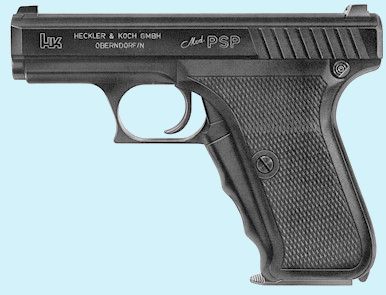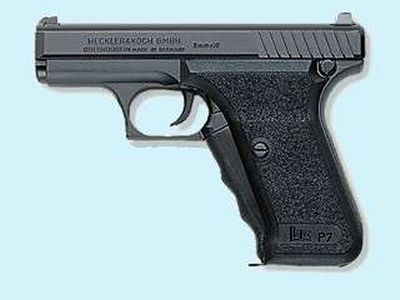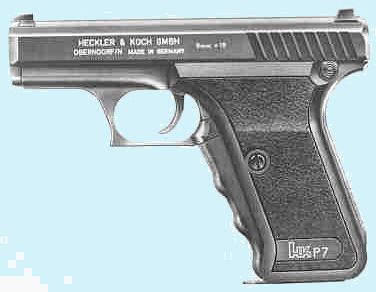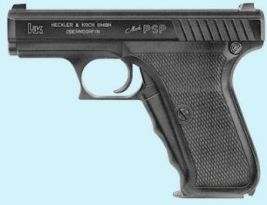Please
navigate this site with
the
menu above,
or
the links at the bottom of
each
page
Finish Caliber(s) Mag. Cap. Barrel Length Overall Length Height Width Across Grips Weight w/o Magazine Weight with Empty Magazine Sight Radius Blue 9 x 19mm 8 4.13" 6.54" 5.00" 1.14" 1.73 lbs. 1.88 lbs. 5.83"
The PSP is the very first member of
the P7 family of pistols. PSP stands for Police Self-loading
Pistol.
It is out of production except for an occasional new production run.
I'm told all the HK factory-types carry the PSP.
It is very similar to the P7M8, the primary visible differences are the PSP's lack of a heat guard above the trigger, and a "European style" magazine release on the butt of the gun. To see the two side by side click here. For a complete list of differences click here.
The PSP has a single-stack magazine that holds 8 rounds. It also has a gas-retarded action and a polygon bore barrel.
Is it a PSP
or a P7 or a
P7 PSP?
The gun in the top photo is clearly a
PSP,
the grips (or at least the one showing) are unmarked. This was the
first version of the P7 legacy. The one below has the grips marked
P7,
no sign of PSP, making it a later gun that was now called a P7
as it's designation in police trials. After the P7M8 came along,
the earlier P7 was referred to as a PSP to keep things straight.
Was any gun ever marked both P7and PSP?. I don't know
for sure, but I don't think so.
Stephen P. Wenger was nice enough to send me this information:
Your website has conflicting photos labeled PSP's. Here's my
recollection:The original version was the PSP, marked as such in the photo at the top of your P7 PSP page. When 9mm Para pistols were submitted for evaluation as West German police guns, they were assigned P number, e.g., P5, P7, etc. Thus the PSP became the P7, with a minor change which I don't recall - it may only have been the grip plates, as evidenced in the difference in the photos at the top and the bottom of your P7 PSP page.
I believe that it was in the early P7 incarnation that the gun was first imported into the US. German police officers found that the first-generation P7 had a tendency to drop its magazine when the butt-heel release rubbed against the rear of their car seats so there was a generational change modifying the release and extending the corners of the grip plates to prevent this occurrence.
In the rush to substitute technology for training and in the aftermath of the murder of one of their officers, the New Jersey State Police told HK that they would adopt the P7 if it could be furnished with the magazine release in the American manner, behind the trigger. Hence the P7 M8, a slightly less concealable gun due to the fact that the squeeze-cocking mechanism precludes a Browning-style button release.
It is probably for this reason that many people prefer the earlier P7 design. I don't know about factory personnel, but the HK USA people refer the earlier P7 as the PSP to distinguish it from the P7 M8, but I don't believe that the factory ever changed the designation.
As an aside, I no longer own a P7. I didn't find its flat shape that ergonomic for me and I found that the sights shifted noticeably when held uncocked vs. when the squeeze-cocker was activated. This last point was probably never a problem in German police work as German police didn't use to draw unless they intended to shoot, unlike American police, who frequently hold felons at gunpoint. The fatter P7 M13 seemed
to fit my hand better but I could never see spending the megabucks for one as it gave up the compactness for concealment. Massad Ayoob claims that he never saw a P7 malfunction in any of his courses. I saw this happen three times while I was teaching with him and one of the three
guns which malfunctioned was mine. I have seen P7's shoot marvelously in the hands of others. If you're curious about my views on handgun selection, check out the website www.spw-duf.info.

A "PSP"

A "P7"

Another "P7"
